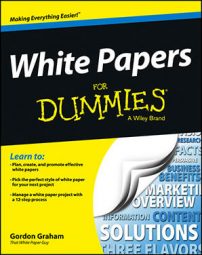The first step in producing a white paper is to create the first-draft text and graphics. Writers, illustrators, designers, and business people understand this step well. This step groups together text and graphics instead of keeping them separate or parallel processes. The visuals in a white paper are vital; in some ways, they’re the most important part. Readers will certainly remember an effective visual.
| Step | Who | What |
|---|---|---|
| 6.1 | Writer | Expands executive summary into draft white paper |
| 6.2 | Writer | Creates all elements and inserts proof points |
| 6.3 | Writer | Polishes text, with help from editor (if any) |
| 6.4 | Writer | Sends first-draft white paper text to client |
| 6.5 | Writer | Creates raw sketches (with help from subject matter experts) and sends them to illustrator |
| 6.6 | Illustrator | Creates rough graphics and sends them to writer |
| 6.7 | Writer | Reviews rough graphics and sends comments (if any) to illustrator |
| 6.8 | Illustrator | Refines rough graphics to incorporate comments |
| 6.9 | Illustrator | Sends first-draft graphics to writer and client |
What the writer does to create the first draft of a white paper
The writer does most of this, with some help from the illustrator (if any) and the editor (if any). The writer expands the approved executive summary into a first-draft white paper, drawing on the research he compiled. The writer creates all the required elements.
The writer inserts enough proof points to make a convincing case and keeps track of all sources in an orderly way. The writer polishes the text through several iterations — or uses the services of an editor — to make the text smooth and persuasive before sending it to the client.
The writer is also responsible for sketching and sending raw graphics to the illustrator. These sketches don’t need to be polished, but they should be clear and complete enough to convey the intended message.
What the illustrator does to create the first draft of a white paper
The illustrator creates preliminary graphics and sends them back to the writer to review. The writer may suggest some refinements so the process loops through Steps 6.6 and 6.7 once or twice before the illustrator sends the first-draft graphics to the client.
Expand the executive summary to create the first draft of a white paper
One quick way to get started is to paste another copy of the executive summary right after the first. Working in the second copy, think of each sentence as the topic sentence for a paragraph, and work at expanding it to a full paragraph or two. Add more thoughts to each point, drawing on what you can easily remember from your research.
Jot down notes and sentence fragments as they come to mind. Don’t even try to make complete sentences at this point, and don’t censor yourself if you depart from the executive summary. You may come up with an interesting sidebar, a new numbered point to add, or another link in your argument that never occurred to anyone yet.
At a certain point, you’ll likely want to dip back into your research. Work back and forth between the summary, your research, your mind map, and your growing ideas any way you want. Later, you can worry about using proper grammar, adding proof points that make every point in your argument as convincing as possible, and making every section engaging and compelling to read.
How to create graphics without an illustrator to create the first draft of a white paper
A professional illustrator normally charges several hundred dollars per graphic. Not every white paper team includes an illustrator, most often because the client never considered allocating any budget for graphics. In this case, the writer usually serves as the illustrator.
Use Creative Commons graphics
You may come across a graphic that’s been released for public use under a Creative Commons license. These are graphics that the creator has willingly shared with the world. But these licenses have different provisions, and artists may not want private companies using their art for commercial purposes. Read the provisions for that graphic carefully to make sure using it in your white paper is permissible.
Create business-quality graphics
You can make your own white paper graphics with PowerPoint, Visio, or SmartDraw. PowerPoint and Visio are both well-known products from Microsoft, where you can drag and drop shapes or add in pieces of clip art. Most people already have PowerPoint on their PCs. The drawback of both programs is that you must start with a blank screen and build everything from scratch.
SmartDraw is less well known but well worth considering if you need business graphics for white papers, slide decks, or blogs. This cost-effective package aimed at non-artists comes bundled with scores of predrawn graphics that are easy to tweak.
Find stock photos
A good stock photo can really dress up the cover of a white paper and visually suggest who the document is aimed at and what it’s about. A stock photo large enough for a white paper cover generally costs less than $30 from a source like iStockphoto.
Review graphics for the first draft of a white paper
Graphics need reviewing, just like text does. The first set of graphics from the illustrator isn’t always perfect. As the writer, your job is to give the graphics a critical viewing and ask yourself whether they’re clear and complete.
Make sure the illustrator understands that you reserve the right to do a round or two of comments and refinements to make the graphics as effective as possible. And then like any reviewer, be precise and constructive.

